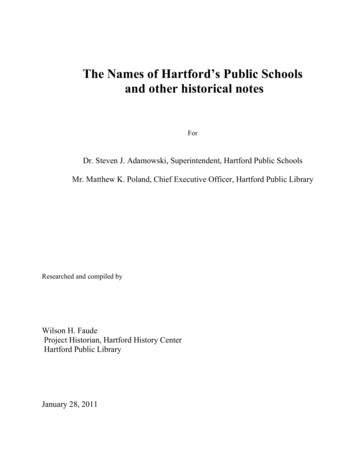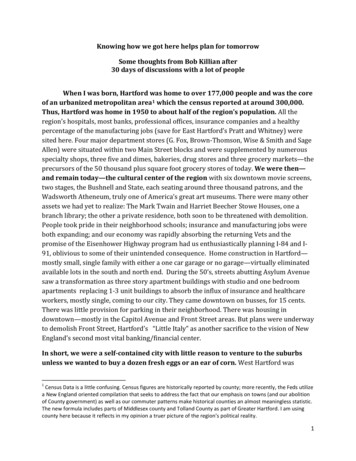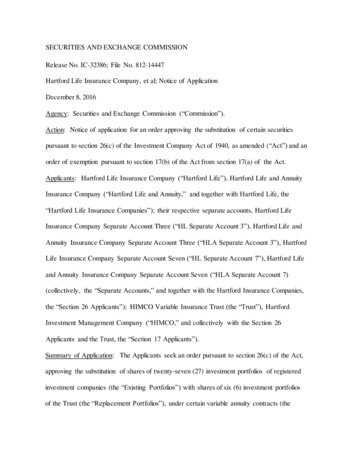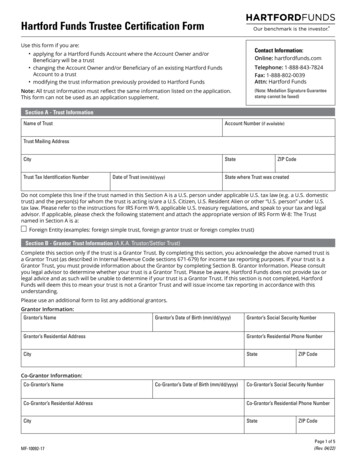
Transcription
The Names of Hartford’s Public Schoolsand other historical notesForDr. Steven J. Adamowski, Superintendent, Hartford Public SchoolsMr. Matthew K. Poland, Chief Executive Officer, Hartford Public LibraryResearched and compiled byWilson H. FaudeProject Historian, Hartford History CenterHartford Public LibraryJanuary 28, 2011
TABLE OF CONTENTSElementaryAnnie Fisher SchoolLouis W. Batchelder Elementary SchoolBetances Early Literacy Lab SchoolDominick F. Burns Latino Studies AcademyAlfred E. Burr Elementary SchoolJohn C. Clark Elementary SchoolHenry C. Dwight Elementary SchoolMichael D. Fox Elementary SchoolMary M. Hooker Elementary SchoolEleanor B. Kennelly Magnet SchoolM.L. King SchoolRichard J. Kinsella Magnet School for the Performing ArtsThomas J. McDonough Elementary SchoolThirman Milner Elementary SchoolCornelius A. Moylan Elementary SchoolDr. James H. Naylor Elementary SchoolSarah J. Rawson Elementary SchoolMaria C. Colon Sanchez Elementary SchoolSimpson-Waverly SchoolFred D. Wish Elementary SchoolPage 1Page 2Page 3Page 4Page 5, 6Page 7Page 8Page 9Page 10Page 11Page 12Page 13Page 14Page 15Page 16Page 17Page 18Page 19Page 20Page 21MiddleDr. Joseph J. Bellizzi Middle SchoolLouis Fox Middle SchoolQuirk Middle SchoolPage 22Page 23Page 24High SchoolMorgan Gardner Bulkeley High SchoolCapital Prep Magnet SchoolHartford Public High SchoolThomas Snell Weaver High SchoolPage 25Page 26Page 27Page 28AddendumWest Middle School110 Washington Street, A.I. Prince Technical High SchoolPage 29Page 30-32
ElementaryAnnie Fisher School280 Plainfield StreetHartford, CT 06112860-695-3500Mascot: TigersMiss Annie Fisher was Hartford’s first female principal and its first female district superintendent. Born inRussia she came to Hartford as a child. She graduated from Hartford Public High School in 1900 andWesleyan University in 1904. She also studied at the Hartford Theological Seminary, Columbia University,schools in Europe and received her master’s degree from New York University. Her first job in Hartfordwas as the librarian at the Hartford Public High School. In 1905 she became the head of the foreigndepartment at the Henry Barnard School. She started Hartford’s first special classes for foreign-bornstudents and wrote two text books for teaching English to foreign-born students: “English for Beginners”and “Learning English”. She also pioneered in helping retarded children. In 1912 she became the head of aspecial child study development programs for retarded and academically slow children.In 1923 she was named the district superintendent of schools. When the school districts were consolidatedin 1934, Annie Fisher became the principal of the Barnard School. She was elected the president of thePrincipals Association for four consecutive terms, and was active in the campaigns of equal pay for womenteachers, pensions and a regular salary schedule. In 1945 she retired. Commentating on her retirement,Superintendent Fred D. Wish, Jr. noted: “she has been a mighty influence in the lives of thousands ofpeople. No matter how large a school was, she knew her individuals and was always the friendly counselorto them.”In 1965 The Hartford Courant published a profile piece on Miss Fisher. It noted that she was “the onlyteacher in her school with a college degree. Very few elementary school teachers in the city had more thannormal school or two-year degrees. Miss Fisher’s innovations started immediately. When she saw the firstgrade room filled with children from 6 to 16, ‘towering boys sitting next to little ones’ all trying to learnEnglish together from one teacher, she asked for the principal’s permission to make different arrangements.I tested them in arithmetic to find out the general level of their education.’ I then ‘placed them in regularclasses for part of the day to speed their adjustment. After all you learn a language best when you hear itspoken.” “One of her more popular innovations, especially among the children, was showers. Up to thattime no elementary schools has showers, although the high schools did for their athletic teams. Miss Fisherwas concerned because many of the immigrant children could not bathe at home since their families had nobath tubs. The twice a week showers, which are still taken by all elementary school children, today, gavenew pride to many of the poor children, she said.”Outside of the school, she was the co-chair of Hartford’s War Relief Commission, in both wars, taughtmissionary groups at the Hartford Seminary Foundation, organized and was the president of the EmanuelSynagogue Sisterhood and organized and was the president of the Young Women’s Hebrew Association.Annie Fisher died on December 24, 1968.On February 18, 1965 the Board of Education unanimously approved, in principle, making the new AnnieFisher School into an experimental laboratory school affiliated with the University of Hartford.In September 1965 the Annie Fisher School opened at 280 Plainfield Street. It was designed by thearchitectural firm of Russell, Gibson and von-Dohlen, for a voter approved bond issue of 2.5 million. Itwas dedicated on April 30, 1966. Albert Freedman, principal of Hartford’s Mary Hooker School was thefirst principal.WHFaudepage 1.
Louis W. Batchelder Elementary School757 New Britain AvenueHartford, CT 06106860-695-2720Mascot: WildcatsMr. Louis W. Batchelder was born in Vermont and received his degree in engineering from the Universityof Vermont in 1914. In 1939 he received an M.A. degree in education from the same university. In 1917 hecame to Hartford to teach in the old South School. A year later he was asked to superintend the southwestdistrict school (now the Kennelly School). He was one of the last of Hartford’s district superintendents toremain active as a principal. Mr. Batchelder retired in 1956.When the Batchelder School opened on New Britain Avenue in 1958, a large number of students weretransferred from the Kennelly School where Mr. Batchelder had been the principal. The newspapersreported that on opening day of the new school that was named in his honor, as he welcomed the students, afirst grader tugged at his sleeve and asked: “Aren’t you the man who’s named after the school?”Mr. Batchelder died on October 22, 1958 at his home at 87 Cumberland Street in Hartford. He is buried inCedar Hill Cemetery.WHFaudepage 2.
Betances Early Literacy Lab School42 Charter Oak AvenueHartford, CT 06106860-695-2840Mascot: BadgersDr. Betances was a Puerto Rican nationalist, instigator of the Grito de Lares revolution and is consideredthe father of the Puerto Rican independence movement. Betances was a renowned medical doctor, surgeon,early social hygienist as well as a public health administrator, diplomat, poet and novelist.Over the main door in 1988 was placed a bronze bas relief sculpture of Dr. Betances by Juan Luis Andreu.Measuring approximately 3.5 feet by 7 feet 3 inches (it has a semi-elliptical top) it was dedicated onNovember 19, 1988, Puerto Rico Discovery Day. The plaque in the school vestibule reads:Dr. Ramon Emerterio Betances Bronze ReliefPresented ToThe Hartford Board of EducationBetances SchoolByLa Casa de Puerto RicoNovember 19, 1988Created ByJuan Luis AndreuThis is reportedly the first piece of public art in Connecticut to honor a Puerto Rican. The sculpture issigned and dated by the artist in the lower left corner of the work.The semi-elliptical bas-relief depicts Dr. Betances and objects relating to his life and to Puerto Ricanhistory. The figure of Dr. Betances is a bust with full, wavy hair and a moustache with a long beard. Hewears a suit coat. There is a chair running horizontally at the bottom of the piece, to symbolize Dr.Betances’s opposition to slavery. A Puerto Rican flag flies behind him. To the left there is a caduceus andto the right a section of El Morro Castle in San Juan.The work was commissioned by La Casa de Puerto Rico for approximately 44,000.The building was built in 1925 as the Richard J. Kinsella School, designed by Whiton and McMahon ofHartford. On November 7, 1985 it was renamed the Betances School in honor of Ramon EmerterioBetances y Alacan (1827-1898).WHFaudePage 3.
Dominick F. Burns Latino Studies Academy195 Putnam StreetHartford, CT 06106860-695-2980Mascot: EaglesDominick F. Burns was born in Stoketown, Roscommon County, Ireland on August 7, 1857. At the age of12 he came with his brother William and settled in Hartford. His first job was at Truman Cowles’s store at84 Main Street in the meat business. In 1877 he went to work for J.P. Newton, a meat store at 341 AsylumStreet. On January 1, 1881 he formed a partnership with T.P. Cannon under the name of Cannon & Burnsand opened a grocery and meat business at 304 Park Street. He later bought out Mr. Cannon and in 1903built the building at the corner of Park and Lawrence streets where he established his grocery store underthe name of D.F. Burns Company. His business continued to grow and had over 25 employees. TheHartford County Retail Grocers’ Association in 1935 honored Mr. Burns as the dean of Connecticutgrocers.Mr. Burns was one of the founders and the first president of the Park Street Trust Company, a trustee of St.Joseph’s Cathedral, director of St. Francis hospital and a member of the Knights of Columbus. In Januaryof 1939 Pope Pius XI conferred upon Mr. Burns the Order of St. Gregory the Great. Mr. Burns was wellknown for his generosity in the Park Street neighborhood and was deeply interested in Mitchell House.Dominic F. Burns died on February 27, 1940 at his home at 530 Prospect Avenue in Hartford.The new Lawrence Street School, designed by Carl J. Malmfeldt, was built in 1938-1940. After Mr. Burns’death it was decided to rename the school in his honor.WHFaudePage 4
Alfred E. Burr Elementary School400 Wethersfield AvenueHartford, CT 06114860-695-3080Mascot: none at this timeAlfred Edmund Burr was born in Hartford on March 27, 1815. His ancestors had come to Hartford in 1635with the earliest settlers. The Burr family was allotted some six acres of land “on the north side of the roadto the cow pasture”. Burr Street was the early name for the portion of Main Street north of Talcott Street. In1827 at the age of 12 Alfred E. Burr became an apprentice in The Hartford Courant’s composing room tolearn the printer’s trade. At 20 he was made the foreman of the room, and at 24 he was offered partialownership in the paper. According to contemporary sources, the “conditions at the paper were such that hedeclined the offer.”The Hartford Weekly Times was first published on January 1, 1817 by Frederick D. Bolles a printer andJames M. Niles a lawyer from Poquonock. According to the Times’ history, they dedicated the paper toforcing the state of Connecticut to have a new constitution, one that would “guarantee civic and religiousfreedom.” Connecticut was still operating under the Colonial charter which required all people to pay taxesto support the Congregational church.” The result was that in 1818 Connecticut ratified a new constitution,one that removed the Congregational Church as the state church. The Hartford Times became the “peoples’newspaper. Niles served as a Senator (1835-1839; 1843-1849) and was postmaster general under PresidentVan Buren. In 1838 the paper was owned by Judge Henry A. Mitchell of Bristol. That year Burr met withJudge Mitchell and offered to purchase half ownership in the paper. One of the paper’s editorial writers,Gideon Welles was in the office when the offer was made. After Burr left, Welles encouraged Mitchell toaccept the offer. On January 1, 1839 Burr became manager and half owner of The Hartford Times. In 1841Burr bought the rest of Mitchell’s interest in the paper.The Hartford Times in 1839 was a weekly newspaper. Burr was the manager, editor, foreman andbookkeeper. On March 2, 1841 Burr changed the paper from a weekly to a daily morning paper. Before theyear was out, he made the Times an evening paper. The circulation rose from 400 to over 2,000 paperswithin the year.Mr. Burr was closely connected with the Democratic Party in the state. For many years any democraticposition or legislation was said to have been partially or wholly written by him, and that no legislation waspassed which he had not read and approved. His obituary noted: “He made his paper democratic, steadfastand rock bound, and for nearly forty-five years nearly everything relating to politics, national and state,came from his hand. He opposed the movement to repeal the Missouri Compromise . . . and his paper stoodwith the supporters of Breckenridge and the South against Stephen A. Douglas and the doctrine of squattersovereignty. He believed that the war which broke out in 1861 had been needlessly forced upon the countryand that it might have been averted by a wise spirit of conservatism and adherence to democraticprinciples.”Mr. Burr was appointed a member of the commission to build the new state Capitol in 1873. Whenopposition arose against placing the Capitol in Bushnell Park, it was Burr’s suggestion that perhaps TrinityCollege could be persuaded to move and the Capitol could then be built just south of the park. Hissuggestion was adopted, Trinity moved to Summit Street and the Capitol was built on its former site. Hewas an early advocate for a centralized water system, today known as the Metropolitan DistrictCommission. He was a trustee of Unity Church, President of the Dime Savings Bank, President of SpringGrove Cemetery and a director of the Connecticut Fire Insurance Company and Case Lockwood andBrainard Company.WHFaudePage 5
Mr. Burr died on January 8, 1900 at his home at 102 Windsor Avenue at the age of 84.His funeral wasconducted at his home and he was buried in Spring Grove Cemetery.In 1914 the Alfred E. Burr School, designed by Whiton and McMahon of Hartford was built at 400Wethersfield Avenue. An addition was added to the school in 1920.Mr. Burr’s daughter, Ella Burr McManus in 1906 established in her will a trust of 50,000 for a wateringtrough for man and beast (horses), in honor of her father, to be “erected in a public way.” In 1923, after thelast beneficiary of the income of the trust had died, it was possible to spend the trust funds for drinkingfountains for men and horses, but they were no longer needed in the city. The trust continued to grow as thedebate continued over what would be an appropriate way to honor Mrs. McManus’s will. Finally it wasagreed in the 1960s to close the public street, between the Wadsworth Atheneum and Hartford’s MunicipalBuilding, known as Atheneum Square South, and create a plaza with fountains and name it the “Alfred E.Burr Mall”. In 1973 Alexander Calder’s sculpture “Stegosaurus” was added to Burr Mall The fact that themall is in front of the Barber’s 1920 Hartford Times building is an appropriate touch. The Hartford Timespublished its final edition on October 20, 1976.WH FaudePage 6
John C. Clark Elementary School75 Clark StreetHartford, CT 06120860-695-3240Mascot: PanthersJohn C. Clark was born in Eastman, Georgia in 1914 and came to Hartford in 1929. He graduated fromHartford Public High School and served as a lieutenant in the U.S. Army in World War II, in both theEuropean and Pacific theaters of operation. He graduated in 1947 from the New England School ofAnatomy and Embalming and in 1957 opened the John C. Clark Funeral Services. He was employed as acontract analyst for the Travelers Insurance Company.In 1955 John C. Clark, Jr. began his political career when he became a candidate for Hartford’s Court ofCommon Council. He received endorsement by the Citizens Charter Committee and entered the Octoberprimary with 37 other candidates. He survived the primary, was endorsed by the Democratic TownCommittee and on November 8, 1955 was elected to the council. He was the first African American toserve on Hartford’s Court of Common Council.In his eight years on the council, Mr. Clark took a strong stand on the fair rent problem in the city anddrafted the legislation that created the Fair Rent Committee. He initiated in 1956 the program to rid the cityof rats and improve housing in the city’s North End. In 1960 he called for a study of the McCookHospital’s needs. In 1961, as the chair of the housing and development committee he advocated a study of“credit blacklisting” in Hartford neighborhoods. In 1960 he was awarded the Hartford Jaycees GoodGovernment award. Mr. Clark retired from the council in 1964.Mr. Clark served as the chair of the Human Relations Committee and the chair of the Education Committeefor the Community Renewal Team of Greater Hartford. In 1965 he was appointed to the HartfordRedevelopment Agency and in 1965 served as a delegate to the Connecticut Constitutional Convention. Hewas a deacon and trustee of the Faith Congregational Church, and a director of the Hartford HeartAssociation.John C. Clark, Jr. died on August 19, 1966 at the age of 52.The original Clark Street School was named for the street where it was located. It had been St. Michael’sSchool, a Catholic parochial school which was purchased by the city for a school. In 1966 Hartford builtthree new schools: the Lewis Fox Middle School on Greenfield Street, the Clark Street Elementary Schoolon Clark Street and the Thomas J. Quirk Middle School on Edwards Street. On September 8, 1966 theHartford Board of Education voted unanimously to name the Clark Street School, the John C. Clark, Jr.School in his honor and in recognition of “his personal contributions to Hartford’s civic life.” The John C.Clark, Jr. School opened in September of 1971.WH FaudePage 7
Henry C. Dwight Elementary School585 Wethersfield AvenueHartford, CT 06114860-695-3400Mascot: DragonsHenry Cecil Dwight was born in Northampton, Mass. on January 19, 1841. He went to school inNorthampton, and attended a classical school in Norfolk, Virginia. After graduating he returned toNorthampton and worked as a clerk in the town’s largest dry goods store. When he learned that Fort Sumterhad been fired on by the Confederates on April 12, 1861, he enlisted in the army. When the Twentyseventh Massachusetts Regiment was being organized, he took an active role in recruiting men, and quicklyrose from the rank of private to sergeant major to second lieutenant to first lieutenant. For his gallantry inthe Burnside campaign he was made a captain of Company A. After the war Dwight returned toNorthampton. In 1865 moved to Hartford and married Miss Anna Marie Wright. He went into businesswith E.N. Kellogg & Co as wool dealers. The business prospered and his firm Dwight, Skinner & Cobecame one of the largest wool firms in the country.Shortly after moving to Hartford, Dwight became active in the city’s politics. In 1871 he represented theCity’s fourth ward on the Court of Common Council and four years later on the Board of Aldermen. In1880 Mayor Morgan G. Bulkeley appointed him to the street board. In 1890 he was elected mayor ofHartford and is credited with greatly developing Hartford’s park system.He was elected a member of the South School District in 1886 and chairman from 1900 to 1918. Thedistrict was the largest in the city with five schools, 150 teachers and over 10,500 students. Dr. JamesNaylor also of the South School District remembered Dwight as “untiring in his work for and his interest inthe children. They were unanimous in their love for him.”Dwight served as paymaster on the staff of Governor H.B. Harrison, and was accorded the rank of general.He was a member of South Congregational Church, a director of Cedar Hill Cemetery, Hartford Hospital,the Phoenix Fire Insurance Company, and the American Industrial Bank and Trust CompanyGeneral Henry C. Dwight died on May 2, 1918 at his home at 23 Charter Oak Place. His funeral was heldat South Congregational Church and he was buried in Cedar Hill CemeteryThe oldest school building in the South School District is the 1883 High Victorian Gothic style brownstoneand polychromed brick building that measures 26 feet by 75 feet. It was designed by Jacob Bachmeyer ofHartford. He is listed as an architect in Hartford from 1880-1890 and then moved to New York City. Theschool opened on October 1, 1883 and was built at a cost of 8,000. In 1901 a large addition was added tothe school. In 1883 there were 108 pupils. Originally called the Wethersfield Avenue School, around 1910it was renamed the Henry C. Dwight School in his honor.Today (2010) the school is called the Dwight-Bellizzi Asian Studies Academy with two campuses:Wethersfield Avenue, PK – 2nd Grade; South Street 3 – 8 Grade.WH FaudePage 8
Michael D. Fox Elementary School470 Maple AvenueHartford, CT 06114Mascot: FoxesMichael D. Fox was born on October 10, 1885 in Clare County, Ireland, the son of Michael and MaryDavitt Fox. In 1908 he was an instructor at LaSallette College and in 1913 became the principal of NewHartford schools. In 1915 he was hired to teach ninth grade at the Alfred E. Burr School. From 1917 to1933 he was the superintendent of the Washington School District and principal of the Washington StreetSchool. As the superintendent of the Washington School District he inaugurated a plan for teachingcrippled children in their homes; started a course in safety that was later adopted by for all Hartfordschools, organized the eight week vacation in the school calendar, and his district was the first in the city tovote pensions for its teachers.Mr. Fox was a great defender of the district school system believing “much greater opportunities forpolitical knavery was possible under a citywide consolidated school system.” For 15 years Mr. Foxweathered the storms. In 1932, on the morning of the district elections, a newspaper reported that therewere “charges of ‘unexplained’, ‘exorbitant’ and ‘unwarranted’ payments running into many thousands ofdollars made in an audit of the Washington School District.” The voters ousted the committee members andin their place voted in persons who had publically stated that if elected they would dismiss Mr. Fox. (Thecharges outlined in the newspaper were later dismissed by the courts.) Mr. Fox refused to resign but he wasout as superintendent.Controversy continued to follow Mr. Fox. The Hartford Board of Education in a 5 to 4 vote decided toshuffle various individuals in order to appoint him acting principal of the Brackett School. There were thenclaims that his permanent supervisor’s certificate was invalid. The city said it was valid, but then theSupreme Court decided it was not. The school board made him the vice-principal of the Arsenal School in1936. The State Board of Education then declared that Hartford would not receive its grant for 1935-1936and continued employment of Mr. Fox would forfeit the 1936-1937 grant of some 200,000. In 1936 Mr.Fox resigned from the Arsenal School. In June of 1936 he applied to the State Board of Education for aspecial permit entitling him to hold an elementary principal’s job. The request was turned down. Membersstated that he did not meet the qualifications for a principal’s certificate, so no exception was warranted.In 1939 Mr. Fox graduated from Westfield Teachers College with a B.S. degree in education. Later thatyear he applied for the position of principal of the Brackett School, but he was not appointed. He becamethe juvenile probation officer of the Hartford Juvenile Court on appointment of Judge William J. Burke andJohn M. Bailey.Michael D. Fox died on November 26, 1946 at his home at 46 Eastview Street at the age of 61. Followingthe funeral at St. Augustine’s Church he was buried in Mt. St. Benedict’s Cemetery.In 1958 in a dramatic reversal of their opinion of him, the Hartford School Board renamed the WashingtonStreet School in his honor. The Washington Street School began as a one-room school in 1842. In 1874that schoolhouse was replaced by a brick building. In 1895, Hartford architect Brooks M. Lincoln absorbedthe 1874 building in a new building. In 1906, 1917 and 1929 other additions and modifications were madeto the school.On September 21, 1976, the Hartford Board of Education decided to rename the “old” Bulkeley HighSchool at 470 Maple Avenue in honor of Michael D. Fox. The Washington Street School/Michael D. FoxSchool was later converted into housing for the elderly. The present Michael D. Fox School was built in1924-1926 and was designed by Frank Irving Cooper with Edward T. Wiley. It is a splendid example of theCollegiate Gothic style. The elaborate front entrance is canted to face the street corner, while each longwing leads to another entrance: one to the gymnasium, the other to the auditorium. In 1922 Cooper haddesigned the Weaver High School, now the M.L. King, Jr. School.WHFaudePage 9
Mary M. Hooker Elementary School200 Sherbrooke AvenueHartford, CT 06114860-695-3760Mascot: HawksMary Mather Turner Hooker was born in Philadelphia, Pennsylvania on February 26, 1864. She waseducated at the Sanford School, and after her marriage to Edward W. Hooker came to Hartford. Herhusband served as Hartford Mayor from 1908 to 1910. When her husband died in 1915, Mrs. Hooker wasnamed to complete his unexpired term as a member of the city’s Board of Education. In 1918 she waselected to the Board on her own right and continued to serve until December of 1937 when she declined reelection. She was the secretary of the Board from June 1918 until June of 1928, when she was elected thepresident of the Board. She served as president from 1928 to 1929 and from 1931 to 1935. She waspresident when the consolidation of the city’s school districts occurred in 1934. She was credited withguiding “the Board through this difficult transition, over and over again averting potential controversies,through her fairness, courtesy and experience.”As a member of the school board she served on the sub-committee dealing with schools for the physicallyhandicapped and the schools for the academically handicapped. She also served on committees oninsurance and cafeterias. In 1920 Mrs. Hooker took part in the deliberations of the Republican State CentralCommittee. In 1921 she was chosen as the Republican candidate for the Connecticut House ofRepresentatives. Mayor Walter Batterson said it was “because of the outstanding regard of the people of thecity for her.” She won the election. She was the first woman member of the State Legislature, and was thefirst woman to make a speech before the House of Representatives. She was re-elected in 1925.Mrs. Hooker was a noted philanthropist. To the Hartford Hospital and Saint Francis Hospital she created afree bed fund, so no one would be turned away. She generously contributed to the children’s pavilion atMount Sinai Hospital. She gave generously to the funds to provide shoes for children, to the CommunityChest, the YMCA, the Salvation Army, various colleges including the Tuskegee Institute. In recognition ofher leadership she was the first honorary member of the Veteran Firemen’s Association, an honorarymember of Boy Scout Troop No 104, a patroness of the United Societies of Saint Patrick Church, aboxholder at a benefit boxing exhibition for Mt. Sinai Hospital, chaired a committee to sell Easter seals,among others. In 1933 she established the Mary M. Hooker Trust Fund of 2,000, the interest to beavailable for prizes, gifts and entertainments at the Hooker school.For many years Mrs. Hooker lived at the Heublein Hotel at the corner of Main and Gold Streets inHartford. She died on May 13, 1939 at the age of 75. Her funeral service was at Center Church and she wasburied in Cedar Hill Cemetery.Several schools in Hartford, at one time or another, have been named for her, in tribute to her service on theschool board and dedication to the teaching of children. The first was the 1925 Ungraded School in theHillyer Homestead on North Main Street. On November 5, 1930 it was renamed the Mary M. HookerSchool. In 1934 the Mary M. Hooker School was consolidated into the Walter G. Camp School. At thattime the school for the physically handicapped, on Stonington Street, formerly the Outdoor School wasrenamed for Mrs. Hooker. During World War II it was abandoned because of its close proximity to ColtFirearms Manufacturing Company. The students were transferred to the Washington Street School. OnNovember 8, 1949 Hartford voters approved the construction of two schools on Sherbrooke Avenue and onLyme Street. The Sherbrooke School was estimated to cost 1,125,000. On January 13, 1950 the HartfordBoard of Education voted to name the one on Sherbrooke Avenue the Mary M. Hooker School. On June 3,1952 the school was formally dedicated. In 2008 the Mary M. Hooker School was transformed into amodern green facility. BL Companies from Meriden designed the 30,000 square-foot addition and otherrenovations for a cost of over 42 million.WH FaudePage 10
Eleanor B. Kennelly Magnet School180 White StreetHartford, CT 06114860-695-3860Mascot: MustangsEleanor Bride Kennelly was born in the Moodus section of East Haddam, Connecticut. She graduated fromMiddletown High School and the Danbury State Teachers College, today Western Connecticut StateUniversity.For many years she taught in the Washington Street School District. She served on the Hartford Board ofEducation from 1931 to 1943 and from 1947 to 1953 for a total of 18 years.On her retirement the Hartford Board of Education voted to rename the Southwest School on White Streetthe Eleanor B. Kennelly School. At the dedication ceremonies on Tuesday, April 20, 1954, former schoolboard president Edward P. Ahern noted: “Eighteen years and about 1,000 meetings on the Board ofEducation won her a school of her own.”On Monday March 18, 1979 she died at the age of 82. She was the widow of Frank A. Kennelly, themother of James J. Kennelly, once a Hartford state representative and Speaker of the House ofRepresentatives. She was the mother-in-law of Barbara Bailey Kennelly, Secretary of State in Connecticut,1979-1982 and Congressperso
Hartford, CT 06106 860-695-2980 Dominick F. Burns was born in Stoketown, Roscommon County, Ireland on August 7, 1857. At the age of 12 he came with his brother William and settled in Hartford. His first job was at Truman Cowles's store at 84 Main Street in the meat business. In 1877 he went to work for J.P. Newton, a meat store at 341 Asylum



![Pageflex Server [document: A0580431 00001] - Capital Insurance Agency, Inc.](/img/29/dor-hartford-group-term-life-brochure.jpg)







